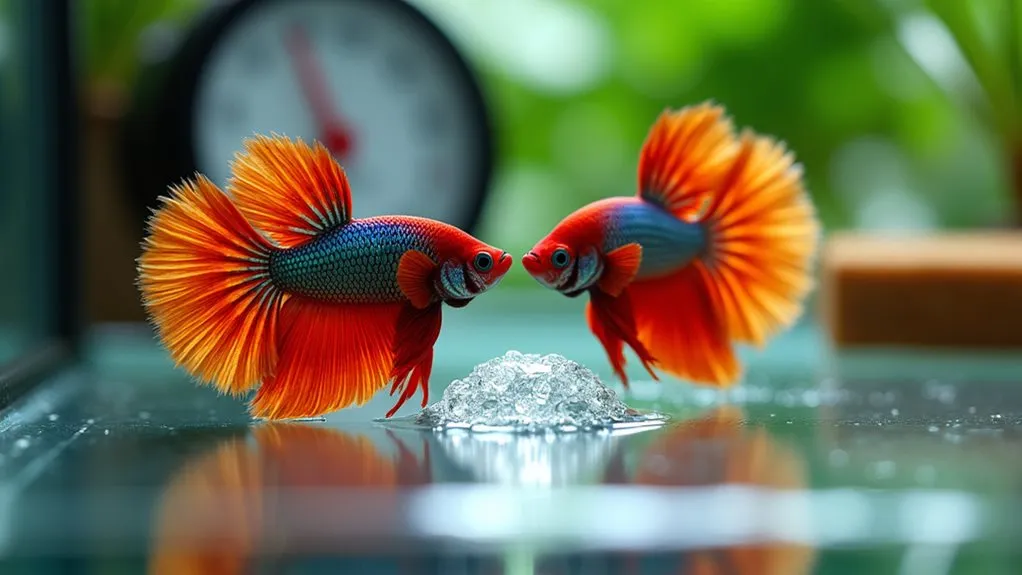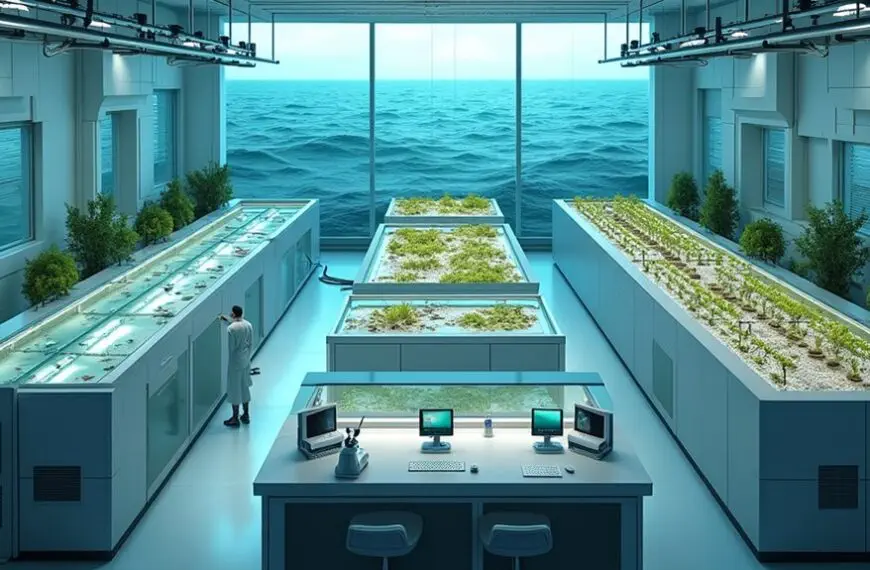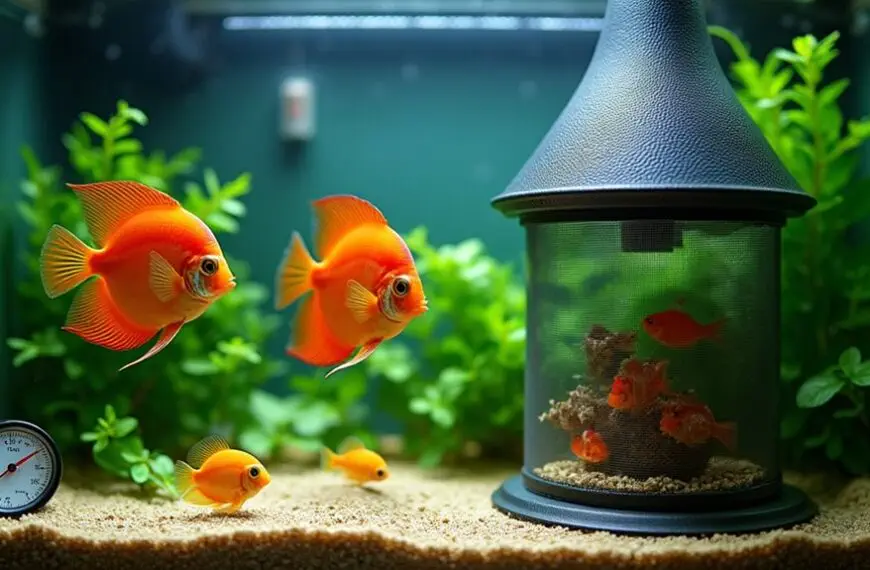For successful fish breeding, start with healthy, mature fish showing readiness to spawn. Set up a 10-20 gallon breeding tank with species-appropriate hiding spots and plants. Maintain stable water parameters and complete the nitrogen cycle before introducing breeders. Feed a high-quality diet to condition your fish, and provide proper post-spawn care for eggs and fry using infusoria or liquid fry food. You'll discover each species has unique breeding behaviors that make this hobby endlessly fascinating.
Contents
- 1 Understanding Spawning Behavior in Different Fish Species
- 2 Setting Up an Ideal Breeding Tank Environment
- 3 Water Parameters and Conditioning for Successful Breeding
- 4 Selecting and Pairing Healthy Breeding Stock
- 5 Nutrition and Dietary Requirements for Breeding Fish
- 6 Natural vs. Artificial Breeding Methods
- 7 Egg Collection and Incubation Techniques
- 8 Caring for Newly Hatched Fry
- 9 Preventing Common Breeding Failures
- 10 Maintaining Genetic Diversity in Home Aquariums
- 11 Frequently Asked Questions
- 11.1 How Long Should I Wait Before Trying to Breed Again?
- 11.2 Can I Breed Fish From Different Geographic Regions Together?
- 11.3 When Is the Best Time to Sell or Give Away Fry?
- 11.4 How Do I Handle Unexpected Aggressive Behavior During Breeding?
- 11.5 Are Certain Fish Easier for Beginners to Breed Successfully?
- 12 Final Thoughts
Understanding Spawning Behavior in Different Fish Species
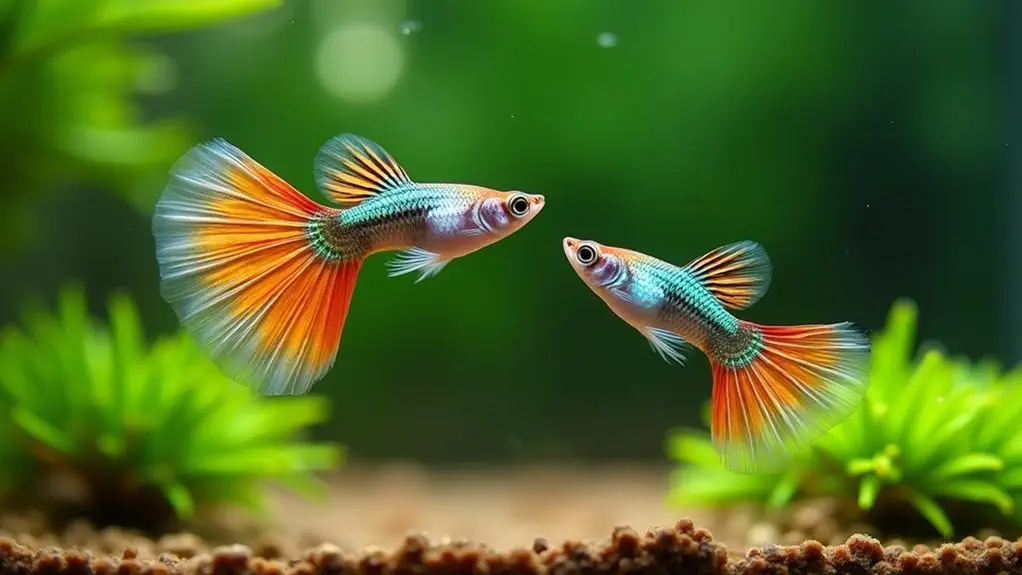
When you're just starting your fish breeding journey, understanding how different species spawn is absolutely essential to your success. Each fish type has unique courtship displays that signal they're ready to reproduce. You'll notice guppies perform intricate dances, while angelfish clean flat surfaces for egg-laying.
Pay attention to species-specific triggers that initiate spawning. Some fish need temperature changes, mimicking seasonal shifts in nature. Others respond to water chemistry adjustments or changes in lighting duration.
Bettas, for instance, build bubble nests when conditions are right, while many cichlids become more territorial and colorful.
Don't get discouraged if your first attempts don't succeed! Breeding fish requires patience and careful observation. Once you recognize these natural behaviors, you'll be better equipped to create the perfect environment for your aquatic friends to reproduce.
Setting Up an Ideal Breeding Tank Environment
Now that you've recognized your fish's spawning signals, it's time to create their perfect love nest. Your breeding tank should be between 10-20 gallons, depending on your fish species, with gentle, adjustable filtration systems to prevent eggs from being sucked away while maintaining water quality.
Tank decor plays an essential role in breeding success. Add plenty of plants (real or silk) where females can deposit eggs and males can guard them. For substrate spawners, include flat stones or breeding slates. Cave-loving species need small pottery or PVC pipes to feel secure.
Every breeding tank tells a love story through its decor—plants for romance, stones for builders, caves for the shy ones.
Keep water parameters stable and species-appropriate—this isn't the time to experiment! Most breeding tanks benefit from slightly warmer temperatures than community tanks. Remember, maintaining ideal water parameters is crucial for the health of your breeding fish and the success of their spawning.
You'll know you've created the right environment when your fish begin their courtship dance.
Water Parameters and Conditioning for Successful Breeding

To raise healthy fish babies, you'll need to get your water conditions just right, including temperature, pH levels, and water hardness specific to your fish species.
Your breeding tank must be properly cycled before introducing your breeding pair, as ammonia spikes can kill eggs and fry.
You'll find that most breeding fish have narrow comfort zones when it comes to water parameters, so invest in quality testing kits to monitor these conditions consistently. Regular water quality checks are essential to prevent toxic buildup that can threaten the health of your breeding fish.
Temperature and Ph Levels
Maintaining proper temperature and pH levels stands as the cornerstone of successful fish breeding, regardless of which species you're working with. Different fish have specific preferences, so research your particular species before setting up your breeding tank.
Most tropical fish thrive between 75-82°F, but temperature fluctuations of even 2-3 degrees can trigger spawning in many species.
Your breeding substrate choice directly impacts spawning success. Some fish, like cichlids, prefer flat rocks, while others need fine sand or even marbles to protect their eggs.
Monitor your pH levels daily—they're just as important as temperature! A slight shift from 7.0 to 6.8 might seem minor to you, but to your fish, it's the difference between breeding readiness and reproductive shutdown. Additionally, maintaining stable pH levels is crucial for preventing stress and health complications in tropical fish.
Don't worry if this seems overwhelming—you'll get the hang of it!
Water Hardness Matters
Why do many novice breeders struggle despite getting temperature and pH correct? Often, the missing piece is water hardness, which plays an essential role in breeding success. Different fish species evolved in specific water conditions, and they need similar environments to trigger their breeding instincts.
- Too hard water can prevent eggs from developing properly in soft water species like tetras.
- Too soft water may lead to weak shells in egg-laying species that need mineral-rich environments.
- Sudden changes in hardness can stress your fish, halting their breeding behavior entirely.
- Your tap water's hardness might be perfect for some species but completely wrong for others.
You'll want to test your water's hardness before selecting breeding species, or learn to adjust it using simple, affordable methods.
Cycling Your Breeding Tank
Beyond water hardness, the nitrogen cycle stands as your breeding tank's foundation for success.
Before introducing your breeders, you'll need to establish this biological process that converts toxic waste into safer compounds.
Start by running your tank for 2-3 weeks with a small amount of fish food or pure ammonia. During this period, beneficial bacteria will colonize your filter media, breaking down ammonia (from fish metabolism) into nitrite, then into less harmful nitrate.
You'll know cycling is complete when ammonia and nitrite read zero, even after adding nutrients.
Don't rush this process! A properly cycled breeding tank prevents stress that could halt spawning behaviors.
Monitoring ammonia levels throughout this cycling process is critical to ensure the long-term health of your breeding environment.
Your future fry will thank you for their clean nursery. Trust me, I've learned this lesson the hard way—cycling isn't optional, it's essential!
Selecting and Pairing Healthy Breeding Stock
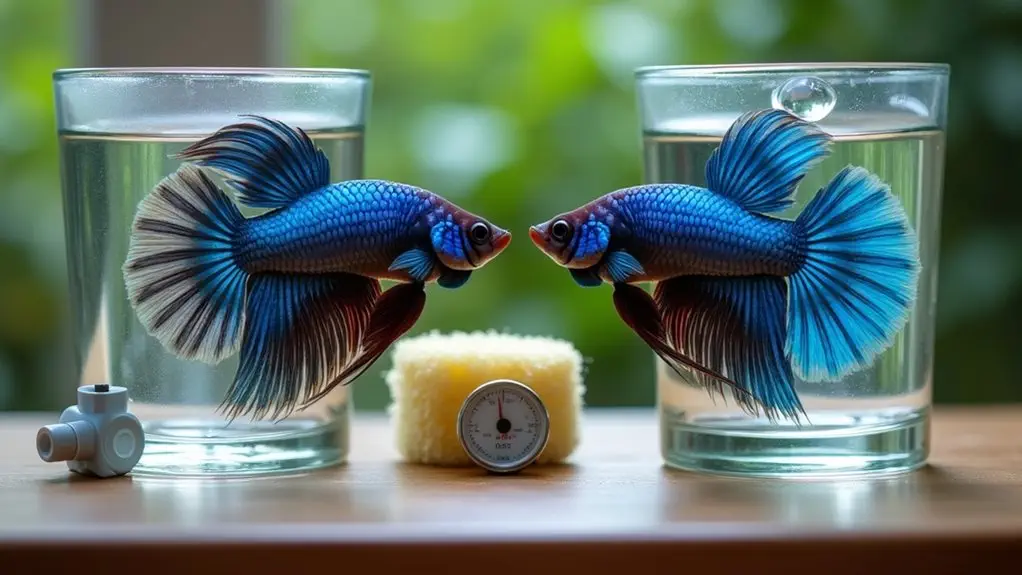
The success of your fish breeding journey depends largely on choosing the right breeding stock. When conducting stock evaluation, look for fish with vibrant colors, complete fins, and active swimming patterns. These visible breeding traits often indicate good genetics that will pass to offspring.
The foundation of successful breeding lies in selecting exceptional stock displaying ideal colors, complete fins, and energetic behavior.
You'll want to select pairs that complement each other's strengths while avoiding any fish showing signs of disease or deformity.
- Choose fish that are mature but not too old (typically 10-12 months for most species)
- Select males and females with ideal size ratios for your species
- Look for balanced body proportions and species-specific trait excellence
- Avoid closely related fish to prevent genetic weaknesses
Additionally, ensure that the selected fish can thrive in compatible community setups, as this will enhance their breeding success and overall health.
Nutrition and Dietary Requirements for Breeding Fish
When preparing your fish for breeding, proper nutrition becomes absolutely critical to their reproductive success.
You'll need to focus on nutrient balance, providing high-quality fish food rich in protein sources that stimulate egg and milt production.
Don't underestimate feeding frequency—most breeding fish need 2-3 small meals daily rather than one large feeding.
Consider dietary supplements like vitamin enrichment solutions that can be added directly to their food. These boost reproductive health and egg viability dramatically!
As your fish move through different growth stages, their nutritional needs will change.
Keep up with health monitoring by watching how they respond to their diet. If their colors fade or they seem lethargic, you'll need to adjust their menu.
Natural vs. Artificial Breeding Methods
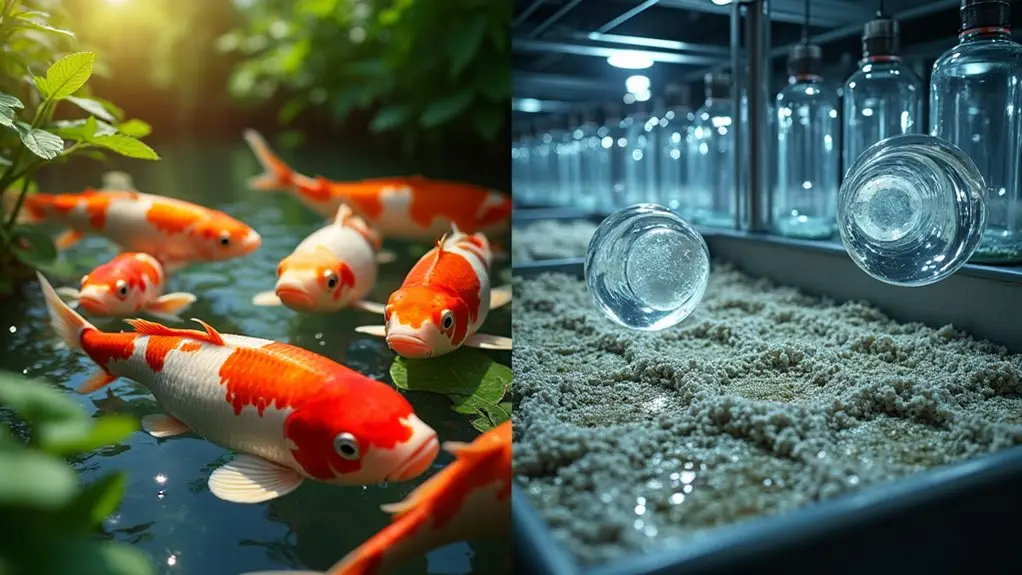
Understanding the difference between natural and artificial breeding methods can dramatically improve your success rate as a beginner fish breeder.
Both approaches have their place in your aquarium hobby, depending on your fish species and available resources.
- Natural breeding mimics wild conditions, using plants, substrate, and environmental triggers like temperature changes to encourage spawning.
- Artificial breeding gives you more control through techniques like hormone injections or manual egg collection and fertilization.
- You'll find natural methods work best for community fish like tetras or guppies, while artificial methods may be necessary for rare or challenging species.
- Don't overlook the middle ground: semi-natural setups where you provide ideal spawning conditions but remove eggs to protect them from predation.
Whichever method you choose, patience and careful observation will be your best tools for success!
Egg Collection and Incubation Techniques
When breeding fish, you'll need to master the art of stripping viable eggs from females, a gentle process that requires practice and patience.
You can collect these eggs by carefully applying pressure to the female's abdomen, moving from head to tail until the eggs release into your waiting container.
Setting up the perfect hatching environment involves controlling water temperature, oxygen levels, and eliminating predators that might eat your precious eggs before they've a chance to develop.
Stripping Viable Eggs
Successful egg collection requires careful timing and gentle technique to avoid harming your breeding fish. When your female fish shows signs of readiness, you'll need to carefully apply gentle pressure along her abdomen to collect the eggs. Proper stripping techniques guarantee maximum egg viability while minimizing stress to the parent fish.
- Cradle the female fish in wet hands, keeping her partially submerged when possible.
- Apply gentle pressure from just behind the pectoral fins toward the vent.
- Collect eggs in a clean, dry container to assess quality before fertilization.
- Stop immediately if you meet resistance—forcing can damage internal organs.
You'll know you've succeeded when bright, translucent eggs flow freely. Remember, practice makes perfect, and you'll become more confident with each breeding season.
Hatching Environment Setup
Creating the perfect hatching environment is essential for turning your carefully collected eggs into healthy fry. You'll want to maintain gentle water circulation that mimics natural conditions without disturbing the eggs. A small air stone placed at a distance can provide just enough movement without causing stress.
Lighting conditions play a vital role too! Keep the hatching container in a dimly lit area, as bright light can harm developing embryos. You might use a timer to maintain a consistent day-night cycle of 12 hours each—your little eggs will appreciate the routine!
Monitor temperature closely, as even small fluctuations can affect development rates. A quality thermometer isn't just helpful—it's your best friend during this nervous, exciting wait for your first baby fish to emerge!
Caring for Newly Hatched Fry

Once your fish eggs have hatched, you'll face the exciting yet challenging task of caring for these tiny, vulnerable creatures. Proper fry feeding is critical during the first weeks of life, as they need small, frequent meals of specialized food.
Keep tank mates separate from your fry, as adult fish might see these tiny swimmers as a tasty snack rather than their offspring!
- Feed infusoria or liquid fry food for the first 3-5 days when fry are too small for other foods
- Perform gentle 10-15% water changes daily to maintain pristine conditions without stressing fry
- Use a sponge filter to prevent tiny fry from being sucked into filtration systems
- Monitor water parameters closely, as fry are much more sensitive to ammonia and pH swings than adults
Preventing Common Breeding Failures
Despite your best efforts, fish breeding can sometimes end in disappointment when you're just starting out. Don't worry—everyone makes breeding mistakes!
To improve your success rate, maintain consistent water parameters, as sudden fluctuations create environmental stress that can trigger egg-eating or abandoned spawning attempts. Regular monitoring of water quality parameters is essential for preventing these stress factors.
Watch your feeding schedule carefully. Overfeeding pollutes the tank and underfeeding leaves breeding pairs without necessary energy reserves.
You'll also want to recognize compatibility issues; some fish simply won't pair up, no matter how perfect your setup seems.
Remember to separate aggressive males or competitors that might disrupt the breeding process. It's like trying to have a romantic dinner with someone constantly interrupting you—not ideal for making baby fish!
With patience and attention to these common pitfalls, you'll soon be watching tiny fry dart around your aquarium.
Maintaining Genetic Diversity in Home Aquariums
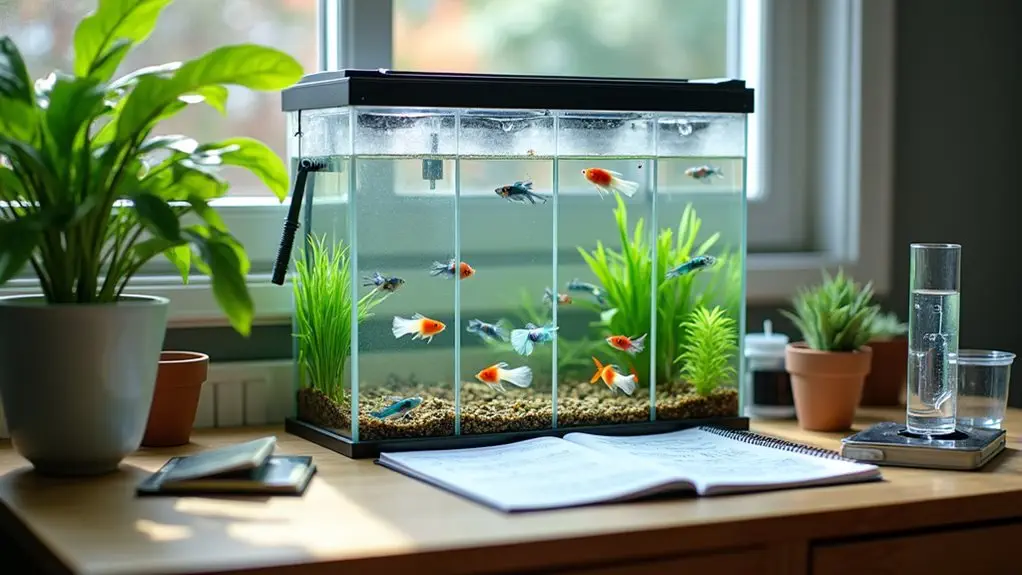
While many beginners focus on simply getting their fish to breed, maintaining genetic diversity in your home aquarium deserves equal attention.
Without proper genetic mixing, you'll soon face issues like weak offspring, deformities, and reduced fertility. Selective breeding can help enhance desirable traits, but you'll need to balance this with maintaining diversity.
Genetic diversity isn't optional—it's essential for preventing the cascade of problems that come with inbreeding.
- Introduce new breeding stock every 3-4 generations to prevent inbreeding
- Keep detailed records of your breeding pairs and their offspring
- Trade fish with other hobbyists to expand your genetic pool
- Look for wild-caught specimens when possible, as they carry diverse genes
Frequently Asked Questions
How Long Should I Wait Before Trying to Breed Again?
You'll want to wait 2-4 weeks between breeding attempts. This recovery time allows your fish to regain strength and health. Proper breeding frequency prevents stress and increases success rates for your next spawn.
Can I Breed Fish From Different Geographic Regions Together?
When an aquarist tried crossing South American tetras with African cichlids, they failed completely. You'll face serious crossbreeding challenges with fish from different regions. Geographic compatibility is essential – stick to fish from the same natural habitats.
When Is the Best Time to Sell or Give Away Fry?
You'll want to sell fry once they've reached ideal selling age—typically when they're 1-2 months old with good fry survival rates. It's best when they're actively swimming and eating on their own.
How Do I Handle Unexpected Aggressive Behavior During Breeding?
While aggression during breeding is instinctive, not malicious, you'll need proper breeding tank setup with hiding spots and dividers. Separate extremely aggressive individuals and research aggressive species management techniques for your specific fish variety.
Are Certain Fish Easier for Beginners to Breed Successfully?
Yes, you'll find guppy care quite manageable as they're livebearers. Platies' compatibility makes them ideal too. Betta breeding requires more attention to aggression, while goldfish spawning demands space and temperature control for success.
Final Thoughts
You're now ready to plunge into fish breeding! With over 85% of first-time breeders succeeding when they follow proper water parameter guidelines, you've got great odds on your side. Remember, patience is your best friend in this hobby. Each successful spawn isn't just rewarding—it's your personal contribution to the aquarium community. Keep learning, keep experimenting, and don't forget to enjoy watching your tiny fry grow into beautiful adult fish!

